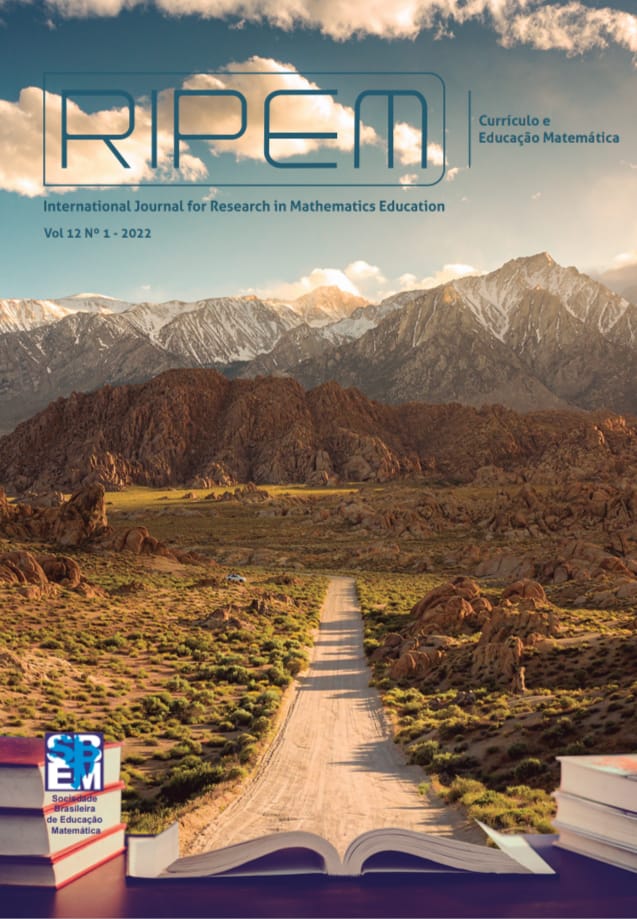Agency and its displacement in the use of Mathematics curriculum materials
DOI:
https://doi.org/10.37001/ripem.v12i1.2884Keywords:
Mathematics Curriculum, Curriculum Materials, Teacher-Curriculum Materials Relationship, AgencyAbstract
The relationship between curriculum materials and teachers who teach Mathematics has been an object of study in the United States since the early 1990s; in Brazil, more recently, this theme has been constituted as a field of investigation in the field of Mathematics Education. In the context of Brazilian discussions, this study aims to understand the shift of agency in the use of curriculum materials by teachers who teach Mathematics. Based on the ideas about professional teacher knowledge that is at the heart of the discussions about the relationship presented here, as well as the concepts of agency and agency displacement that occur in the teacher's planning and action process, we resorted to a semi-structured interview with four teachers who teach Math. Subsidized by the methodological lens of the Meaning Nucleus, we identified as a result of the apprehension of senses and meanings that teachers sometimes assume themselves as agency, sometimes delegate agency to the textbook. In some situations, students are also recognized as agency, and there are even times when teachers give decision-making power or agency to both the materials and themselves, almost simultaneously. Discussions show that shifting agency requires more understanding of the role of teachers and materials in curriculum development, as well as the mobilization of knowledge about Mathematics, its teaching and curriculum.
Downloads
References
Aguiar, W. M. J. & Ozella, S. (2006). Núcleos de significação como instrumento para a apreensão da constituição dos sentidos. Psicologia: Ciência e Profissão, BrasÃlia, 26(2), 222-246.
Ball, D. L.; Hill, H. C. & Bass, H. (2005). Knowing Mathematics for teaching: who knows mathematics well enough to teach third grand, and how can we decide? American Educator, Washington, 29(1), 14-17, 20-22, 43-46.
Ball, D. L.; Thames, M. H. & Phelps, G. (2008). Content knowledge for teaching: what makes it special? Journal of Teacher Education, Washington, 59(5), 389-407.
Brown, M. W. (2009). The Teacher-Tool Relationship: theorizing the design and use of curriculum materials. In: Remillard, J. T; Herbel-Eisenmann, B. A. & Lloyd, G. M. (Ed.). Mathematics Teachers at Work: connecting curriculum materials and classroom instruction (pp. 17-36). New York: Taylor & Francis.
Collopy, R (2003). Curriculum materials as a professional development tool: how a Mathematics textbook affected two teachers' learning. The Elementary School Journal, Chicago, 103(3), 287-311.
Giddens, A. (1989). A constituição da sociedade. Tradução de Ãlvaro Cabral. São Paulo: Martins Fontes.
Giddens, A. (1991). As consequências da modernidade. Tradução de Raul Fiker. 5. reimpressão. São Paulo: EdUNESP.
Januario, G. & Lima, K. (2019). Materiais curriculares como ferramentas de aprendizagem do professor que ensina Matemática. Revista Paranaense de Educação Matemática, 8(17), 414-433.
Januario, G. (2020). Agência, affordance e a relação professor-materiais curriculares em Educação Matemática. Ensino em Re-Vista. Uberlândia, 27(3), 1055-1076.
Januario, G. (2017). Marco conceitual para estudar a relação entre materiais curriculares e professores de Matemática. 194f. Tese (Doutorado em Educação Matemática) — Faculdade de Ciências Exatas e Tecnologia. PontifÃcia Universidade Católica de São Paulo. São Paulo.
Januario, G. & Manrique, A. L. (2019). Teachers’ interactions with curriculum materials in Mathematics Education. Acta Scientiae, Canoas, 21(3), 2-23.
Lima, K. (2017). Relação professor-materiais curriculares em Educação Matemática: uma análise a partir de elementos dos recursos do currÃculo e dos recursos dos professores. 163f. Tese (Doutorado em Educação Matemática) — Faculdade de Ciências Exatas e Tecnologia. PontifÃcia Universidade Católica de São Paulo. São Paulo.
Manzini, E. J. (2003). Considerações sobre a elaboração de roteiro para entrevista semi-estruturada. In: Marquezine, M. C.; Almeida, M. A. & Omote, S. (Org.). Colóquios sobre pesquisa em Educação Especial (pp. 11-25). Londrina: EdUEL.
Pires, C. M. C. (2013). Projeto de pesquisa Relações entre professores e materiais que apresentam o currÃculo de Matemática: um campo emergencial. São Paulo: PUC-SP.
Remillard, J. T. & Kim, O. (2017). Knowledge of curriculum embedded mathematics: exploring a critical domain of teaching. Educational Studies in Mathematics, 96, 65-81.
Remillard, J. T. (2005). Examining key concepts in research on teachers’use of Mathematics Curricula. Review of Educational Research, Washington, 75(2), 211-246.
Soares, M. C. R. A. (2020). A relação professor-materiais curriculares de Matemática: análise na perspectiva dos conceitos de affordance e agência. 142f. Dissertação (Mestrado em Educação) — Centro de Ciências Humanas. Universidade Estadual de Montes Claros. Montes Claros.
Souto, L. S. (2021). Relação professor-materiais curriculares educativos: uma análise dos enlaces do ensinar entre a Educação FÃsica e a Matemática. 152f. Dissertação (Mestrado em Educação) — Centro de Ciências Humanas. Universidade Estadual de Montes Claros. Montes Claros.
Vigotsky, L. S. (1998). Pensamento e linguagem. Tradução de Jefferson Luiz Camargo. São Paulo: Martins Fontes.
Published
How to Cite
Issue
Section

This work is licensed under a Creative Commons Attribution-NonCommercial-NoDerivatives 4.0 International License.








